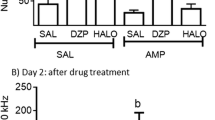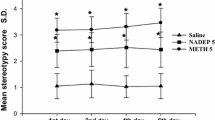Abstract
The effects of flurazepam (0.0, 0.5, and 3.0 mg/kg) on methylphenidate-induced increases in stereotypy, gnawing, sniffing, and locomotion were evaluated in Swiss-Webster mice in daytime and night-time experiments. Methylphenidate (50 mg/kg) increased overall stereotypy and stereotyped gnawing behavior; two doses of methylphenidate (25 mg/kg and 50 mg/kg) increased locomotion and sniffing behavior. Flurazepam 3.0 mg/kg augmented methylphenidate-induced stereotyped gnawing behavior and stereotypy. Flurazepam significantly decreased locomotion and sniffing, but did not interact with methylphenidate's effects on locomotion and sniffing.
Similar content being viewed by others
References
Babbini M, Montanaro N, Strocchi P, Giaardi M (1971) Enhancement of amphetamine-induced stereotyped behavior by benzodiazepines. Eur J Pharmacol 13:330–340
Blackwell B (1973) Psychotropic drugs in use today: the role of diazepam in medical practice. J.A.M.A. 225:1637
Chiueh C, Moore K (1975) Blockade by reserpine of methylphenidate induced release of brain dopamine. J Pharmacol Exp Ther 2:559–563
Greenblatt DJ, Miller RR (1974) Rational use of psychotropic drugs I. Hypnotics. Am J Hosp Pharm 31:990–995
Greenblatt DJ, Shader RI (1974) Benzodiazepines in clincial practice. Raven Press, New York
Herman ZS (1967) Influence of some psychotropic and adrenergic blocking agents upon amphetamine stereotyped behavior in white rats. Psychopharmacologia 11:136–142
Kales A, Kales JD, Scharf MB, Tan TL (1970) Hypnotics and altered sleep patterns: II. All night EEG studies of chloral hydrate, flurazepam, and methaqualone. Arch Gen. Psychiatry 23:219–225
Kales A, Kales JD, Bixler EO, Scharf MB (1975) Effectiveness of hypnotic drugs with prolonged use: Flurazepam and pentobarbital. Clin Pharmacol Ther 18:356–363
Koch-Weser J, Greenblatt DJ (1974) The archaic barbiturate hypnotics. N Engl J Med 291:790–791
Lal S, Sourkes TL, Missala K (1974) The effect of certain tranquilizers, chlorpromazine metabolites and diethyldithiocarbamate on tissue amphetamine levels in the rat. Arch Int Pharmacodyn Ther 207:122–130
Randall LO, Schallek W, Scheckel CL, Stefko PL, Banziger RF, Pool W, Moe RA (1969) Pharmacolgical studies of flurazepam hydrochloride (R 05-6901), a new psychotropic agent of the benzodiazepine class. Arch Int Pharmacodyn Ther 178:216–241
Randrup A, Munkvad I (1965) Special antagonism of amphetamine-induced abnormal behavior. Psychopharmacologia 7:416–422
Scheel-Kruger J (1971) Comparative studies of various amphetamine analogues demonstrating different interactions with the metabolism of the catecholamines in the brain. Eur J Pharmacol 24:47–59
Sleeping Pills, Insomnia, and Medical Practice (1979) Institute of Medicine. National Academy of Sciences, Washington, D.C.
Taylor KM, Laverty R (1969) The effect of chlordiazepoxide, diazepam, and nitrazepam on catecholamine metabolism in regions of the rat brain. Eur J Pharmacol 8:296–301
Author information
Authors and Affiliations
Rights and permissions
About this article
Cite this article
Risch, C., Kripke, D. & Janowsky, D. Flurazepam effects on methylphenidate-induced stereotyped behavior. Psychopharmacology 70, 79–82 (1980). https://doi.org/10.1007/BF00432374
Received:
Accepted:
Issue Date:
DOI: https://doi.org/10.1007/BF00432374




